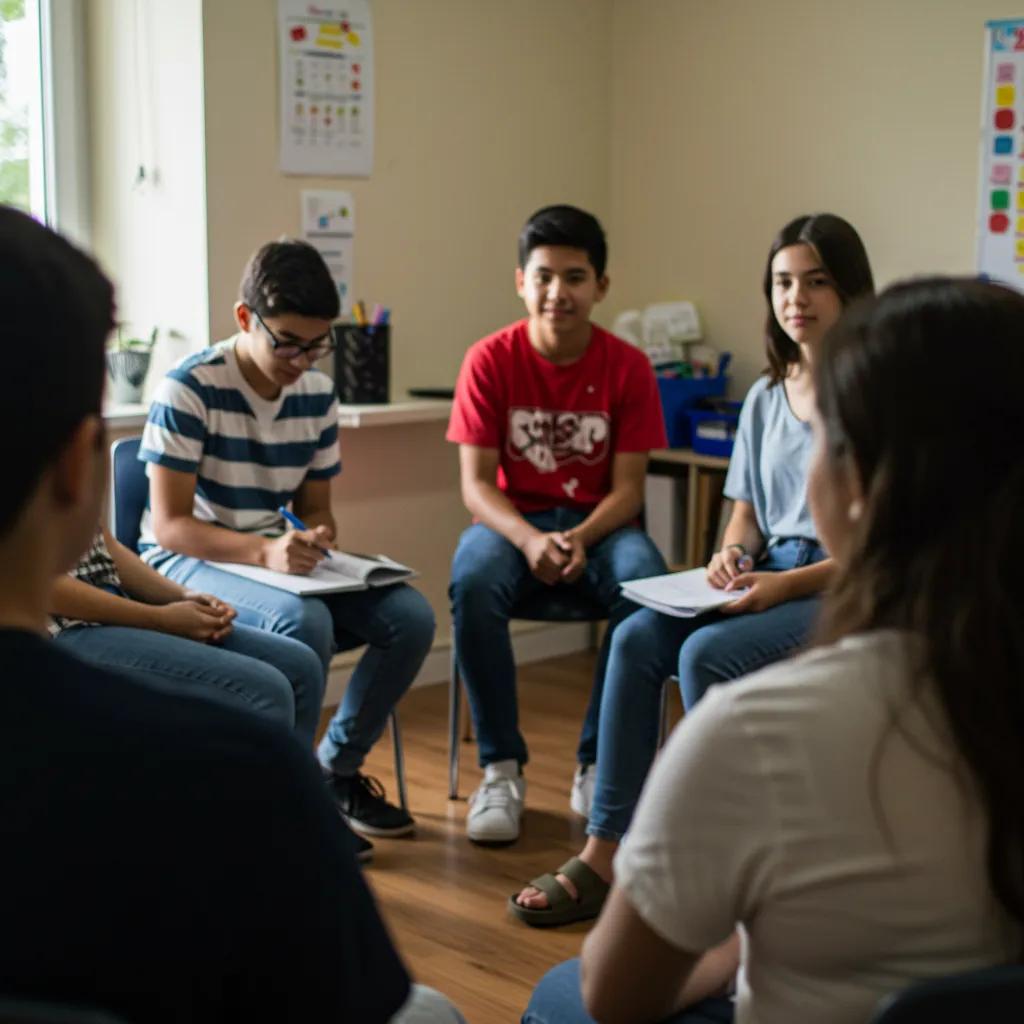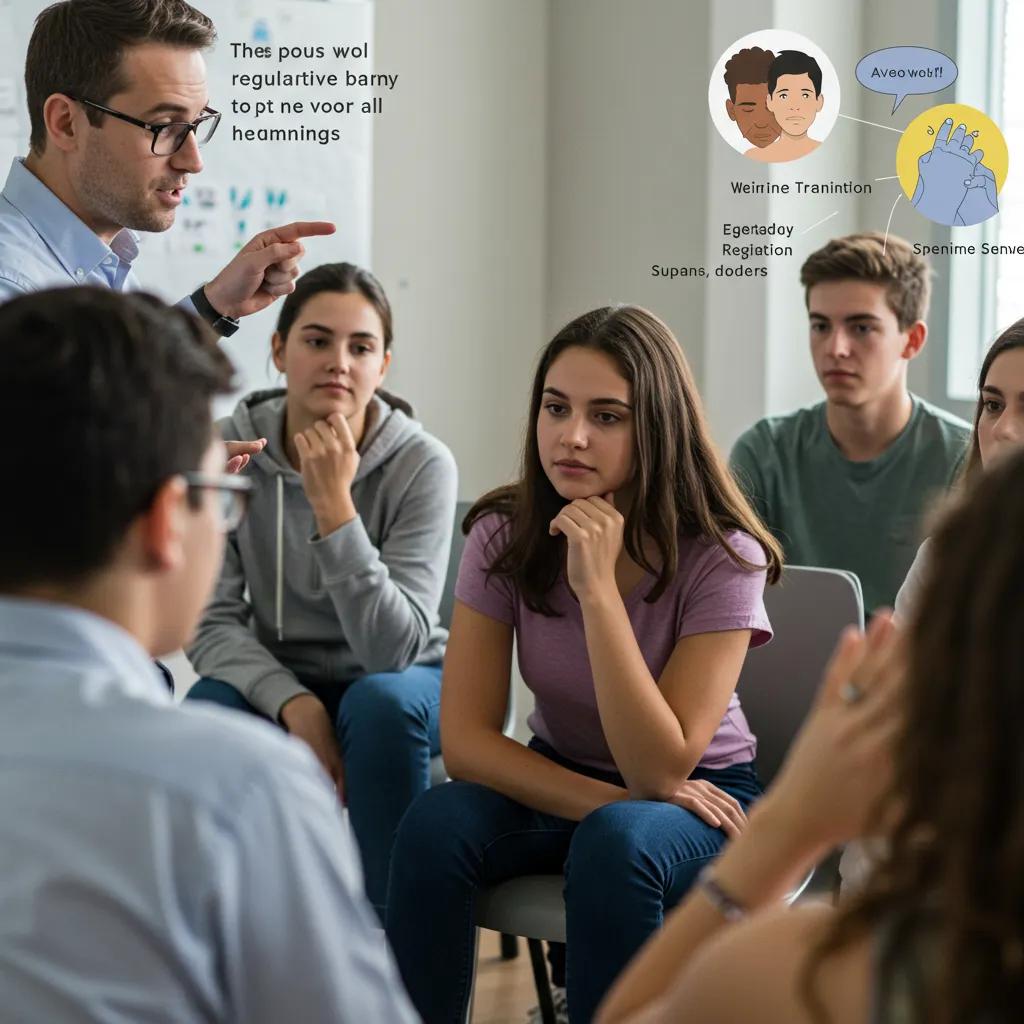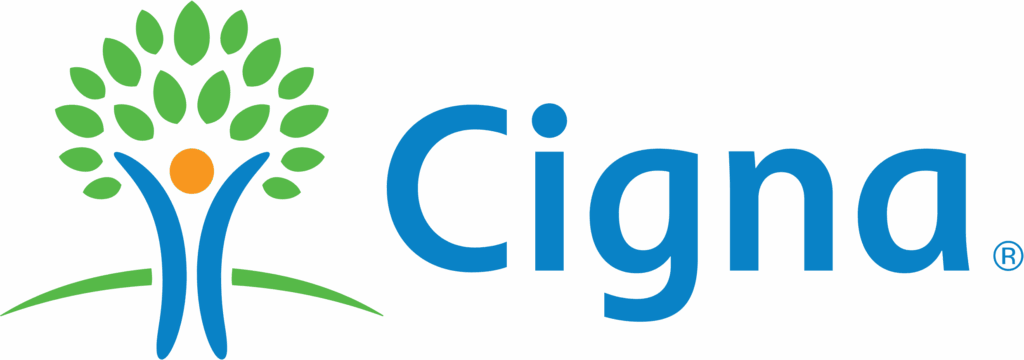
Adolescent intensive outpatient programs (IOPs) provide structured, evidence-based behavioral health care that lets teens live at home while receiving frequent, coordinated treatment. This guide explains what a teen mental health IOP is, how it works, which conditions it treats, the core therapies used (CBT, DBT, family therapy, medication management), and where IOP sits in the continuum of care. Many families face escalating symptoms—worsening depression, anxiety, self-harm, or co-occurring substance use—that outpatient weekly therapy can’t fully address; IOPs close that gap by combining group skill-building, individual therapy, and family interventions. Readers will learn how programs structure days and weeks, what skills teens learn, practical steps for choosing a provider, and how to plan aftercare so gains last. The article covers program features, common clinical presentations treated in IOPs, detailed descriptions of therapeutic modalities, sample daily flows, evaluation checklists for families, and transition planning after discharge.
A teen intensive outpatient program is a structured outpatient service that delivers concentrated mental health treatment through regular sessions several days per week while the adolescent continues to live at home. The mechanism is a coordinated package of group skills training, individual therapy, family sessions, and medication management that produces symptom reduction and functional gains without 24/7 hospitalization. The key benefit is combining therapeutic intensity with school and family continuity so teens practice skills in real-world settings and transfer learning home. Core components typically include skills-based groups (CBT/DBT), individual psychotherapy, family therapy, and psychiatric review when needed.
Teen IOPs generally run multiple days per week for several weeks to months, and the interdisciplinary team includes therapists, a psychiatrist or psychiatric nurse practitioner, and a case manager who coordinates school and community supports. Understanding program length and components helps families compare programs and set expectations for progress. The next section explains how adolescent IOPs support mental health through skill acquisition, peer normalization, and family involvement.

An adolescent IOP supports mental health by delivering intensive, evidence-based interventions that teach coping and emotional regulation skills, reduce symptoms, and restore daily functioning. The mechanism uses guided practice—group modules teach DBT distress tolerance and emotion regulation, CBT targets unhelpful thinking with thought records, and individual therapy personalizes goals—so teens build competency and resilience. A clear benefit is rapid skill acquisition with ongoing practice between sessions, which accelerates symptom relief compared with weekly therapy. For example, a teen with panic-related avoidance will learn exposure practices in group and apply them during school with clinician and family support, creating measurable behavior change.
This model leverages peer feedback and family coaching to generalize skills to home and school contexts. Those social and systemic supports increase adherence and reduce relapse risk, and they naturally lead to decisions about stepping intensity up or down as progress is tracked.
Teen IOPs combine repeated sessions across modalities with clear admission and discharge criteria and a multidisciplinary staffing model focused on safety and recovery. Programs typically require several hours per day, multiple days per week, and an established treatment plan with measurable goals and progress metrics. Staff usually include licensed therapists trained in adolescent modalities, a psychiatric prescriber for medication management, and case managers who coordinate school plans and community referrals. Admission criteria commonly include moderate-to-severe symptoms that impair functioning but not a need for 24/7 supervision.
Programs define discharge around symptom stabilization, skills mastery, and a concrete aftercare plan so gains persist. The next subsection contrasts IOP with other levels of care so families can decide when IOP is the right fit.
IOP differs from other levels of care by intensity, supervision, and living arrangements: it offers high-frequency outpatient therapy without overnight stays, while PHP provides full-day services and residential care includes 24/7 supervision. The mechanism of difference is the level of monitoring and structure—IOP balances intensity with home integration, PHP provides more hours and clinical observation, and residential care supplies continuous safety for acute risk. Key benefits of IOP are maintaining school participation and family life while receiving concentrated treatment, which contrasts with PHP or residential options that require temporary removal from home.
Families should escalate to PHP or residential care when safety concerns, inability to function in community settings, or lack of outpatient response exist. To make this comparison clearer, the table below summarizes each level of care.
| Level of Care | Intensity / Daily Time | Typical Length | When Appropriate |
|---|---|---|---|
| Outpatient Therapy | 1 session/week, low intensity | Ongoing monthly | Mild-moderate symptoms manageable with weekly support |
| Intensive Outpatient Program (IOP) | 3–5 hours/day, 2–5 days/week | 4–12 weeks typical | Moderate symptoms requiring skill-focused, frequent therapy |
| Partial Hospitalization Program (PHP) | 6–8 hours/day, 5 days/week | 1–6 weeks | Significant impairment needing full-day structured care |
| Residential Treatment | 24/7 care, continuous supervision | Weeks to months | Safety risks, severe instability, or lack of home supports |
This comparison helps families determine the right setting based on supervision needs, symptom severity, and the goal of reintegration into school and family life.
Teen IOPs treat a range of adolescent mental health conditions by combining targeted therapies and coordinated supports to produce functional recovery. Programs commonly address mood disorders, anxiety disorders, trauma-related conditions, substance use disorders, behavioral challenges, and co-occurring presentations by adapting evidence-based interventions to adolescent development. The practical benefit is tailoring a modular treatment plan—for example, coupling CBT for depression with motivational interviewing for substance use—to address multiple interacting problems.
Common conditions treated include:
After listing conditions, the table below maps typical IOP interventions to expected outcomes for clarity.
| Condition | IOP Interventions | Typical Outcomes |
|---|---|---|
| Depression | CBT, behavioral activation, individual therapy | Reduced depressive symptoms, improved engagement |
| Anxiety | CBT with exposure, group skills, relaxation training | Decreased avoidance, improved coping in school/social settings |
| Trauma-related | Trauma-focused CBT, stabilization skills, TF-informed groups | Improved emotional regulation and decreased reactivity |
| Substance use | Integrated SUD modules, motivational interviewing, peer support | Reduced use, increased readiness for recovery supports |
| Self-harm / suicidal thoughts | Safety planning, DBT skills, family support | Fewer crises, improved distress tolerance and safety |
This mapping helps parents understand how specific modalities produce measurable changes in functioning and symptoms. The next section explains the main therapeutic approaches used in IOPs and why they matter.
IOP addresses anxiety and depression by delivering high-frequency CBT techniques, behavioral activation, exposure work, and structured skill practice within group and individual formats. The mechanism uses repeated exposure and cognitive restructuring to recalibrate unhelpful thought patterns and gradually increase behavioral activation for low-motivation depression. The benefit is quicker symptom reduction and restored daily functioning, as teens practice skills in sessions and between-session assignments. For example, a teen with social anxiety follows a graded exposure plan developed in individual therapy and rehearsed in group to translate gains into school participation.
Progress is tracked through standardized measures and observable behavior changes, and peer groups reinforce practice and normalize struggles so teens sustain improvements. These combined approaches create measurable steps toward returning to full academic and social involvement.
Beyond mood and anxiety disorders, IOPs adapt modules for substance use, oppositional behaviors, disordered eating, and self-harm by integrating specialized content and safety protocols. The mechanism is modular adaptation—adding SUD-focused motivational interviewing and relapse prevention, incorporating trauma stabilization for complex presentations, and creating safety plans for self-harm risk. Expected benefits include reductions in risky behaviors, improved family problem-solving, and established crisis plans. Programs coordinate with medical and nutritional providers for eating disorder concerns and with addiction specialists when appropriate.
Safety planning and close monitoring are essential elements, and clinicians adjust intensity or refer to higher-level care when risk or medical needs exceed outpatient capacity. This integration reduces fragmentation and supports concurrent treatment of co-occurring conditions.
Trauma-informed care in IOPs applies principles of safety, trustworthiness, choice, collaboration, and empowerment while embedding trauma-specific interventions like trauma-focused CBT and stabilization skills. The mechanism is creating predictable routines, psychoeducation about trauma responses, and stepwise exposure or processing when the teen is stabilized. The benefit is minimized re-traumatization and improved ability to engage in therapeutic work safely. Staff training in trauma sensitivity and clear referral pathways to specialized trauma services support this approach.
Programs routinely assess trauma history, implement grounding and regulation modules early, and coordinate with trauma specialists for complex cases to ensure that interventions are developmentally appropriate and culturally sensitive.
Core modalities in teen IOPs are evidence-based therapies adapted to adolescent development, and together they create the mechanism for symptom change and skill generalization. Each modality offers a distinct benefit: CBT restructures thinking and builds behavioral activation, DBT teaches emotion regulation and distress tolerance, family therapy repairs communication and supports skill reinforcement at home, and medication management treats biological contributors in combination with therapy. The result is a multi-pronged plan that addresses cognition, behavior, emotion, and systems.
Below is a concise list of primary modalities commonly used in teen IOPs.
Efficacy of Cognitive Behavioral Therapy (CBT) for Adolescent Anxiety Disorders
Cognitive behavioral therapies (CBTs) have demonstrated efficacy in treating anxiety disorders among children and adolescents. Randomized clinical trials suggest that approximately two-thirds of children receiving CBT achieve remission from their primary diagnosis post-treatment. While various CBT treatment protocols have been examined in youth with diverse anxiety disorders, common core components have been identified. These core procedures for treating anxiety disorders in youth include comprehensive assessment, establishing a strong therapeutic relationship and working alliance, cognitive restructuring, systematic exposure with avoidance reduction, and skills training.
Cognitive behavioral therapy for anxiety disorders in youth, LD Seligman, 2011
Group therapy benefits teens by providing peer-led normalization, opportunities for social skills practice, and repeated guided rehearsal of skills like DBT emotion regulation and CBT coping strategies. The mechanism uses peer feedback and structured exercises to accelerate learning and reduce isolation. Typical group topics include emotion regulation, coping with anxiety, relapse prevention for SUD, and communication skills. The outcome is measurable increases in social confidence, expanded coping repertoires, and a sense of accountability.
Safety and confidentiality are emphasized with clear group agreements and clinician moderation to manage risks like contagion or triggering content. Groups complement individual work by providing contexts for practicing skills in real time.
Individual therapy in IOPs personalizes treatment through case formulation, targeted skill coaching, and progress monitoring, serving as the mechanism that translates group-learned skills into personal goals. The benefit is addressing idiosyncratic patterns—trauma processing, identity issues, or medication side effects—through focused work. Individual sessions often provide homework planning, crisis planning, and motivational enhancement tailored to the teen’s readiness. Coordination with the group and family sessions ensures consistency and transfer of gains across settings.
Clinicians track progress with validated measures and adjust interventions when needed, which supports gradual reduction of intensity as skills solidify.
Family therapy improves treatment outcomes by shifting family interactions that maintain symptoms, teaching parental coaching skills, and building collaborative relapse prevention plans. The mechanism is changing patterns of communication and reinforcement so new teen behaviors are supported rather than undermined at home. Practical benefits include clearer household routines, reduced conflict, and better supervision around safety and substance use concerns. Parent-focused modules often teach validation, limit-setting, and how to support exposure or homework tasks.
When families participate, treatment gains generalize more reliably to daily life, reducing the chance of symptom recurrence after discharge.
Medication management in IOPs integrates psychiatric assessment and collaborative monitoring into the treatment plan for teens with biological contributors to mood, anxiety, or attention disorders. The mechanism involves baseline evaluation, informed consent discussions (with parental involvement as required), initiation or adjustment of medications, and scheduled follow-ups to monitor efficacy and side effects. The benefit is symptom reduction that enhances engagement in psychotherapy and functional recovery. Medications are combined with therapy rather than replacing skills work, and clinicians emphasize education about risks, benefits, and adherence.
Coordination between prescribers and therapists ensures medication decisions are informed by behavioral progress and family preferences.

Teen IOPs deliver multiple benefits across the adolescent and family system by building practical skills, improving family communication, and preserving school participation while providing intensive treatment. The mechanism centers on skills acquisition through repeated practice and immediate application at home and school, which accelerates recovery and restores daily functioning. Benefits include faster reduction in symptoms compared with standard outpatient care, stronger family support systems, and the ability to maintain academic progress. Families often report improved problem-solving, clearer expectations, and reduced crisis frequency as a result.
Below is a practical list summarizing the primary benefits families can expect from IOP participation.
IOP programs teach concrete coping and regulation skills via repeated instruction, role-play, and between-session practice so teens internalize techniques like cognitive restructuring and DBT distress tolerance. The mechanism is frequent, scaffolded practice within a safe group setting, reinforced in individual sessions and by families at home. The benefit is improved ability to manage crises, decreased impulsive behaviors, and enhanced emotional awareness. For parents, staff provide exercises to practice with their teen—such as brief role-play or cueing techniques—to reinforce skill use during real-life triggers.
Measuring skill acquisition through behavior tracking and standardized tools helps clinicians know when to reduce intensity or shift focus toward maintenance.
Peer support enhances recovery by normalizing experiences, offering role models of coping, and creating accountability for practicing new skills. The mechanism involves structured group activities that encourage sharing, feedback, and guided behavioral experiments. Benefits include reduced shame, improved social skills, and enhanced motivation to apply therapy outside sessions. Clinicians manage group dynamics to prevent negative peer influence and to foster safe, constructive interactions.
Parents can observe improvements in their teen’s social interaction and confidence as a sign of group-related progress, which feeds into family reinforcement strategies.
Family involvement improves outcomes by aligning home supports with therapeutic goals, training parents to reinforce adaptive behaviors, and creating shared relapse prevention strategies. The mechanism uses family therapy, parental coaching, and collaborative planning so the adolescent’s environment supports sustained change. Benefits include fewer crises, clearer communication, and consistent reinforcement of therapeutic assignments. Practical modules teach parents to validate emotions, set boundaries, and coordinate with schools.
Family engagement is often the difference between short-term symptom reduction and long-term recovery because most adolescent problems are embedded in family and school systems.
IOP offers flexibility by allowing teens to remain in their home, maintain school attendance, and practice skills in natural contexts while still receiving frequent, intensive therapeutic input. The mechanism is a part-time, high-frequency schedule that balances clinical oversight with real-world exposure. Benefits include lower disruption to education, lower cost than residential care, and faster application of learned strategies in daily life. Some trade-offs include less continuous supervision, which requires reliable home supports and safety planning.
Families should weigh these trade-offs against clinical needs to decide whether IOP provides sufficient structure for stabilization.
A typical day in a teen mental health IOP combines check-in, group skills modules, individual or family sessions, and planning time so adolescents receive both structured learning and personalized care. The mechanism is predictable routine—morning check-ins, skill-focused group blocks, short breaks, and individual sessions—that supports regulation and engagement. The benefit is clarity for teens and families about expectations, which enhances adherence and reduces anxiety about treatment. Below is an illustrative description and a table that compares session types by duration, goals, and activities.
| Session Type | Typical Duration | Primary Goals | Typical Activities |
|---|---|---|---|
| Group Therapy | 60–90 minutes | Teach and practice skills | Skills training, role-play, group exercises |
| Individual Therapy | 30–45 minutes | Personal case work and planning | Goal setting, problem solving, homework review |
| Family Session | 30–60 minutes (periodic) | Improve communication and supports | Parent coaching, conflict resolution, planning |
| Medication Management | 15–30 minutes (weekly/biweekly) | Symptom monitoring and meds adjustment | Psychiatric review, side-effect checks |
A sample IOP day often begins with a brief check-in and symptom screen, followed by a skills-based group session, a short break, an individual session or smaller skills workshop, and end-of-day planning with family or case manager. The mechanism of flow supports ramping up emotional activation with structured skill practice and then consolidating learning through individual review and homework planning. Benefits include predictable transitions that reduce anxiety and enable regular measurement of progress. Consent and privacy procedures are explained on arrival, and clinicians document daily observations to inform treatment adjustments.
Clear daily structure helps teens apply skills during the week and prepares families for facilitating homework and school communication.
Group, individual, and family sessions are scheduled to maximize skill acquisition and generalization—groups provide core instruction multiple times per week, individual sessions target personalized challenges, and family meetings occur periodically to align supports. The mechanism is coordinated scheduling based on clinical needs: many programs run two to three group sessions per week plus one individual session and biweekly family meetings, adjusting frequency as progress is made. The benefit is flexibility to intensify individual attention when crises arise or shift emphasis to family work when needed. Programs typically taper group intensity as skills consolidate and transition toward outpatient weekly therapy.
This scheduling strategy creates a predictable progression from intensive skill-building to maintenance-focused care.
IOPs often include academic coordination, life-skills modules, and reintegration planning so teens maintain or resume school responsibilities while building executive functioning and daily routines. The mechanism is direct liaison with schools (with appropriate consent), homework planning, and teaching time-management, sleep hygiene, and study skills within programming. Benefits include fewer academic disruptions and clearer plans for excused absences or catch-up work. Programs may provide letters or structured plans for schools to support accommodations and reintegration.
Families receive guidance on communicating with schools and on documenting necessary consents to facilitate educational support.
Choosing the right IOP requires evaluating clinical fit, staff credentials, treatment approaches, outcomes measurement, logistics, and telehealth options. The mechanism is a structured evaluation—asking focused questions and reviewing program features—to match adolescent needs to services offered. The benefit is increased likelihood of good outcomes when program modalities and intensity align with the teen’s diagnosis, risk level, and family circumstances. The checklist below gives the top questions families should ask when evaluating providers.
Use this checklist during initial calls or intake appointments to compare programs objectively.
These questions help families make evidence-based comparisons across programs. After asking these questions, families should request an intake assessment to determine fit and next steps.
Practical next steps for families include requesting a clinical assessment, gathering relevant medical and school documentation, and preparing a brief history of symptoms and previous treatments. When ready, contact local licensed providers or your pediatrician for referrals and to schedule an initial assessment.
Families should prioritize questions about clinician licensure, treatment models, outcome tracking, crisis procedures, and family involvement to assess program quality and fit. The mechanism is targeted inquiry that clarifies whether the program’s approach matches clinical needs and logistical constraints. The benefit is ensuring transparency and alignment before committing to care. Top-priority questions include those in the checklist above and should be used as a printable intake checklist.
Using a structured list during intake helps families compare options and make informed decisions about next steps.
Accreditation and staff credentials indicate adherence to recognized care standards and quality assurance processes, which function as signals of program reliability. The mechanism involves external review by accrediting bodies and verification of professional licensing for clinicians. The benefit is greater confidence in clinical oversight, safety protocols, and documentation practices. Families should ask which accreditations the program holds, verify clinician licenses, and be alert to red flags such as unclear credential verification or reluctance to share outcome metrics.
Accreditation is one factor among many—families should also evaluate treatment approach, staff fit, and logistical compatibility.
Virtual IOP options increase access and convenience by delivering group and individual therapy via secure platforms, but they also introduce engagement and privacy considerations that families must weigh. The mechanism for virtual care is synchronous video sessions, digital assignments, and telehealth check-ins that replicate core therapeutic elements remotely. Benefits include reduced travel and expanded access for rural families, while limitations include potential distractions, variable home privacy, and technology barriers. Families should confirm platform security, emergency procedures for remote crises, and whether hybrid options are available.
When virtual IOP is appropriate—such as when travel is prohibitive or specialized local services are unavailable—it can be as effective as in-person care for many adolescents when privacy and engagement are ensured.
After completing a teen IOP, coordinated transition planning focuses on sustaining skills, scheduling follow-up care, and integrating school and community supports to prevent relapse. The mechanism is an individualized aftercare plan that outlines outpatient therapy connections, booster sessions, medication follow-ups, and school coordination. The benefit is maintaining momentum and reducing risk of symptom recurrence through structured ongoing supports. Below are recommended follow-up steps and resource types families should consider.
Transition and follow-up care are managed with a stepwise timeline that assigns responsibilities to clinicians, families, and schools, and schedules early post-discharge check-ins to ensure continuity. The mechanism includes confirming an outpatient therapist, arranging medication follow-up with a prescriber, and creating a written relapse prevention plan. Benefits include early detection of setbacks and prompt adjustments to the care plan. Clinicians typically schedule a 1–2 week post-discharge check, then monthly reviews, and coordinate documentation for school accommodations as needed.
Families should ensure contact information for providers and crisis resources is accessible and agree on who will initiate appointments to prevent gaps in care.
A range of resources—peer support groups, community mental health services, school counselors, self-help apps, and crisis hotlines—supports maintenance of gains after IOP completion. The mechanism is layering community and professional supports that reinforce skills and provide rapid help if symptoms re-emerge. Benefits include continued social support, opportunities for booster learning, and access to emergency services if needed. Families should evaluate resources for credibility, evidence base, and local relevance.
Examples include school-based counseling, structured peer recovery groups for SUD, parent training workshops, and vetted digital tools for mood tracking and skills practice.
Maintaining gains long-term requires a written relapse prevention plan, scheduled booster sessions, consistent family support, and healthy daily routines that reinforce emotional regulation and functioning. The mechanism is ongoing practice, periodic clinical review, and environment-level changes (sleep, activity, social supports) that sustain resilience. The benefit is reduced recurrence of symptoms and quicker response to emerging warning signs. Teens should continue routine check-ins with a therapist or prescriber, use coping plans developed in IOP, and engage in supportive peer or community activities.
Next steps for families include scheduling regular follow-up appointments, maintaining a visible relapse prevention plan at home, and coordinating with school supports to ensure academic continuity and mental health monitoring.
We are 100% in Network Provider. Most of our clients pay $0 out of pocket.



